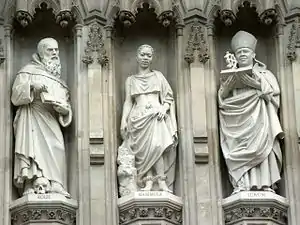Manche Masemola
Manche Masemola (1913–1928) was a South African Christian martyr.
Manche Masemola | |
|---|---|
 Masemola Statue (center) - Westminster Abbey | |
| Martyr | |
| Born | 1913 |
| Died | 1928 (aged 14–15) |
| Venerated in | Anglican Communion |
| Feast | 4 February |
Early life
Masemola was born in Marishane, a small village near Jane Furse, in South Africa. She lived with her parents, two older brothers, a sister, and a cousin. German and then English missionaries had worked in the Transvaal Colony for several decades and by the early twentieth century there was a small Christian community among the Pedi people which was widely viewed with distrust by the remainder of the tribe who still practiced the traditional religion.
Martyrdom
By 1919, an Anglican Community of the Resurrection mission was established by Fr. Augustine Moeka in Marishane. Masemola attended classes in preparation for baptism with her cousin Lucia, against the wishes of her parents. Her parents took her to a Sangoma (African traditional healer), claiming that she had been bewitched. She was prescribed a traditional remedy, which her parents made her consume by beating her.[1] Relations worsened, and the mother hid the girl's clothes so she could not attend Christian instructional classes.[2] On February 4, 1928, her parents led the teenager to a lonely place, where they killed her, burying her by a granite rock on a remote hillside.[2]
Manche had said that she would be baptized in her own blood. She died without having been baptized.
Manche's mother converted to Christianity and was baptised forty years later in 1969. Manche was declared a martyr by the Church of the Province of Southern Africa in less than ten years.
Commemoration
The Anglican Church of Southern Africa commemorates Manche in its Calendar of saints on the 4th day of February each year, as do some other churches in the Anglican Communion.[3] She is one of the ten 20th-century martyrs from across the world who are depicted in statues above the Great West Door of Westminster Abbey, London.[4]
Notes and references
- St. James 2008, p. 71–.
- Quinn.
- Chandler 2007, p. 89.
- Presler 2001, p. 85.
- Chandler, Andrew (2007). Br Tristam SSF and Simon Kershaw (ed.). Exciting Holiness. Norwich: Canterbury Press. ISBN 978-1-85311-806-7.CS1 maint: ref=harv (link)
- Davie, Lucille (4 February 2008). "Alex honours Africa's only saint (sic)". Official website of the City of Johannesburg. Retrieved 2014-08-06.
- Goedhals, Mandy (1998). "Imperialism, mission and conversion: Manche Masemola of Sekhukhuneland". In Andrew Chandler (ed.). Terrible Alternative: Christian Martyrdom in the 20th Century. Continuum International Publishing Group, Limited. ISBN 978-0-8264-4844-6.CS1 maint: ref=harv (link)
- Presler, Titus (2001). Horizons of Mission. Cowley Publications. p. 85. ISBN 978-1-4616-6060-6.CS1 maint: ref=harv (link)
- Quinn, Frederick (2002). African Saints: Saints, Martyrs, and Holy People from the Continent of Africa. Crossroad. ISBN 978-0-8245-1971-1.CS1 maint: ref=harv (link)
- Quinn, Frederick. "Manche Masemola, South Africa, Anglican". Dictionary of African Christian Biography. Retrieved 2014-08-06.
- St. James, Rebecca (2008). Sister Freaks: Stories of Women Who Gave Up Everything for God. FaithWords. ISBN 978-0-446-55016-1.CS1 maint: ref=harv (link)
- The story of Manche Masemola and her fight for faith (video). BBC. Retrieved 6 Aug 2014.